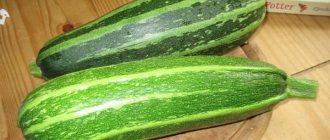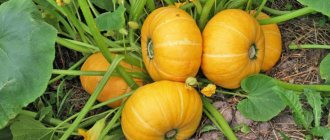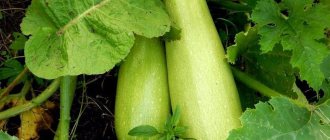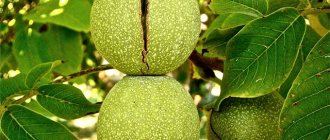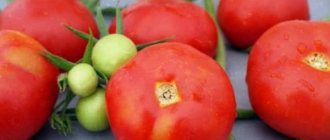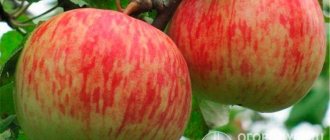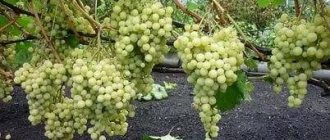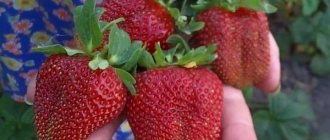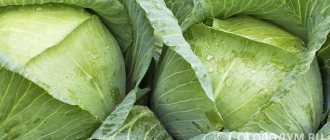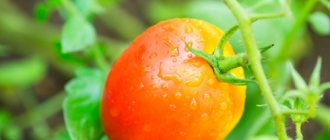Zucchini has long gained popularity due to its numerous beneficial properties and extreme unpretentiousness to growing conditions. The second feature of the plant, namely its undemandingness to climatic and weather conditions, as well as care, makes zucchini one of the most common vegetables in central Russia. The Moscow region is no exception to this rule; gardeners in the region actively grow the plant, achieving excellent results both in open ground and in film-covered greenhouses and greenhouses.
Zucchini: plant description
This annual plant has the shape of a bush. On our plots we plant two types:
Zucchini leaves are five-lobed. These “palms” are prickly to the touch due to the rough pubescence. Flowers are divided into male and female, so the crop is cross-pollinated, although a large number of parthenocarpic hybrids have now been bred - forming fruits without pollination.
Zucchini is native to northern Mexico. Initially, Mexicans ate only seeds.
The fruit itself is a false berry. It has an elongated or cylindrical shape. Typically, the flesh of the fruit is white and the seeds are cream-colored. The growing season is 2.5–3 months. The plant begins to grow no earlier than the air temperature rises to 15 °C - this is a heat-loving crop. Zucchini does not tolerate shade, so for planting you need to choose open, sunny areas.
It grows well on cultivated fertile soils, is responsive to the application of organic fertilizers, has low requirements for moisture and does not require abundant watering. Susceptible to the same diseases as cucumbers. Fully ripened zucchini of almost all varieties can be stored well at room temperature. Most of them are early ripening, but if you use seedlings, you can get the harvest even faster.
By the way, zucchini is a close relative of pumpkin, or rather, its variety.
Recommendations for growing different species
To properly grow a plant, you need to familiarize yourself with the peculiarities of cultivating different types of zucchini.
Early ripening
It is recommended to plant early-ripening varieties of zucchini in compost beds, since in ordinary soil they will grow slowly and bear fruit poorly. It is necessary to arrange the compost bed in two layers:
- First layer. First, a hole is dug, the bottom of which is covered with limp potato tops and dried plant debris.
- Second layer. You need to add a little last year's compost on top.
Mid-season
Zucchini with medium ripening periods need fertilizing that promotes fruiting. The bushes must be periodically fed with mineral and organic fertilizers, which contain magnesium, nitrogen and calcium.
Late ripening
To speed up the ripening of late-ripening vegetables, they have to be fed and watered more often. For watering, use water warmed to room temperature. Potassium nitrate and superphosphate are used as fertilizers.
The best varieties of zucchini for the Moscow region
Many varieties of zucchini have passed the appropriate tests, approved and entered into the register specifically for the Central region of the country, including the Moscow region. Residents of the respective regions should pay their attention to these varieties.
Zucchini for open ground
Varieties that require pollination by insects are usually planted in open ground.
In greenhouses they will have to be pollinated by hand, which is quite troublesome. Zucchini growing in open ground has a richer taste and color due to sunlight. They suffer less from diseases such as powdery mildew and various rots. Despite different resistance to diseases, all varieties require preventive spraying against powdery mildew.
The register of breeding achievements includes dozens of varieties intended for cultivation in private plots of the Moscow region. They all differ in appearance, taste and ripening time, but are equally useful in their chemical composition. It is more convenient to care for bush varieties, such as:
- yellow-fruited,
- White-fruited,
- Tintoretto,
- Sosnovsky,
- Tsukesha,
- Velizh,
- Gribovskie 37,
- Aeronaut,
- Belogor,
- Tsuboda,
- Pharaoh,
- Emerald,
- Karam,
- Kavili,
- Sangroom,
- Black handsome man
- Delicacy,
- Miletus,
- Russian Spaghetti,
- Coal,
- Ball,
- Sir,
- Goodwin,
- Karizma,
- Tiger cub,
- Soraya,
- Karina,
- Astoria,
- Boatswain,
- Vanyusha,
- Apollo,
- Masha,
- Skvorushka,
- Lena,
- Emerald,
- Miracle orange
- Lord,
- Vilina,
- Murzilka,
- Scilly,
- Aimaran,
- Golden Key,
- Bumblebee,
- Daphne,
- Gherkin,
- Nevira,
- Moor,
- Profit,
- Snezhnogorsk,
- Sadko,
- Dragon.
For livestock
Large zucchini containing hard seeds in the pulp are grown as feed for cattle. They are best stored without freezing, retaining a maximum of useful vitamins, macro- and microelements.
Winter Russian size and Gribovskie 37 are the best of their kind. For many years they grow in gardeners' gardens without requiring special care. With minimal needs, climbing zucchini perfectly decorates the garden, giving it originality and beauty.
The appearance of the bushes is expressive, characterized by large, symmetrically growing leaves and bright yellow flowers. The fruit plant looks best in flower beds and beds located near fences and borders.
Zucchini planted in barrels and tires stacked on top of each other also look unusual. True, in order for vegetables to have the best greens and large fruits, do not forget about fertilizing in the form of eggshells, horse manure or compost.
If you want to diversify your garden with bright fruits, you can choose varieties for planting that are distinguished not only by rich greenery, but also by unusual zucchini, painted in sunny tones - yellow or orange. Among these: hybrid varieties “Tender Zephyr” and “Orange” with the designation F1.
Early varieties of zucchini for the Moscow region
Although the climate in the Moscow region is not too warm, many gardeners want to get their harvest as early as possible. Early ripening varieties of zucchini are excellent for this.
Helena
Early variety for fresh and canned consumption -
41–57 days pass from germination to ripeness of the first fruits. Entered into the register in 1997.
By type it is a bush zucchini. The leaves are large, dark green, pentagonal in shape. Ripe fruits reach a weight of 0.5–0.9 kg. They are cylindrical, smooth, and the skin color ranges from golden yellow to orange. The pulp is yellowish, excellent taste. The seeds are small, light cream. In the Moscow region, about 580 centners are harvested per hectare of land.
The disadvantages include the following:
- can become infected with powdery mildew and white rot of fruits;
- weakly susceptible to peronosporosis - downy mildew.
The fruit of the Helena squash variety at the stage of incomplete maturity is yellow in color.
An early ripening variety intended for vegetable gardens, personal plots and small farms -
From planting to ripeness, only 48–51 days pass.
This is a bush squash. The fruits reach a weight of 1.5–2.2 kg, they are round and ribbed, and the pulp is tender and sweet. The seeds are large. The color of a fully ripened fruit is speckled yellow, but light green, unripe zucchini is eaten. From one square meter you can collect up to 11 kg per season.
The variety is valued for the following qualities:
- great taste
- stable harvest
- original form.
Tintoretto is not used for preservation, but in home cooking it has no equal.
The Tintoretto variety of zucchini has a round, ribbed shape and a distinct taste.
Kveta MS
Early ripening zucchini, recommended for growing in garden plots,
from germination to ripeness - 34–54 days. On the register since 1997.
This is a semi-bush that forms only one main vine. It is quite long - up to a meter. The fruit is cylindrical in shape, slightly reminiscent of a club when ripe. The color is whitish at all stages of maturity. The pulp is white-yellow, tender.
- Moderately susceptible to downy mildew and fungal rot of fruits,
- requires treatment against powdery mildew.
- stable harvest
- excellent taste (one of the best zucchini for canning and making delicious caviar).
The most delicious squash caviar is obtained from the fruits of the Kveta MS variety.
Emerald
Early ripening table variety -
from germination to maturity - 33–46 days. On the register since 2003.
This is a bush with a short main vine. The green leaves are spotted and medium in size. The fruits are long, dark green with spots, cylindrical, smooth and shiny, like wax, weighing 0.9–1.3 kg. Zucchini produces fruit early and quickly, which is very productive and tasty, for which it is valued.
Zucchini variety Emerald produces beautiful fruits
Conversion tables for Russian clothing sizes
Choosing suitable workwear that does not tighten or restrict movement, and does not look baggy is not an easy task. But it is much easier to cope with it if you study the size charts of clothing.
Overalls are necessary to protect workers from possible injuries and effects on the skin of substances with which they have to work. The correct size of the work uniform is important, since not only the comfort of the employee, but also the quality of performance of work duties depends on it.
We suggest you familiarize yourself with How often to wash workwear at an enterprise
When selecting the optimal size of women's work equipment, it is necessary to take into account some parameters:
- female breast circumference - it is determined by dividing the measurement result in half (for example, when the chest volume is 92 cm, the desired size is 46);
- hip girth;
- height - this parameter should be ideal, the maximum variation in size is no more than 3 cm up or down;
- girth at the narrowest part of the tummy (at the waist).
The parameters of work clothes are determined by GOST and are designed for the typical figure of a woman.
Choosing workwear for men involves the same dimensions as when choosing workwear for women. You will need to measure:
- height - be aware that the men's height scale is significantly different from the women's;
- chest and hip circumference;
- girth of the narrowest part of the abdomen (waist).
The parameters of work clothes for men are designed for the average figure and are determined by GOST.
Not all manufacturers use clothing labels that are common in Russia. To avoid any difficulties with purchasing workwear, the size of which is indicated in a different format, below is a table for converting clothing sizes.
You can determine the girth of a body part using an ordinary centimeter tailor's tape. To do this you need:
- measure the circumference of the chest along the most protruding parts, drawing a centimeter along the hollows of the armpits;
- measure your hips along the most protruding parts of your buttocks;
- Waist circumference is determined by the narrowest point;
- Height can be measured using a stadiometer.
Parthenocarpic varieties of zucchini for the Moscow region
These are zucchini plants that produce fruit without pollination.
They have underdeveloped seeds or no seeds at all. Most often these are hybrids intended for greenhouses, where there are no pollinating insects, but they can also be planted in open ground. Planting and caring for such plants is no different from ordinary ones. The package with seeds is always marked as parthenocarpic.
By the way, in a stressful situation, many common varieties of zucchini can form a parthenocarpic fruit.
Ball
An early ripening bush variety for greenhouses and open ground.
It has original spherical fruits that ripen in 50–55 days. “Watermelons” are whitish in color with small spots and weigh 0.8–2.1 kg. The variety has:
- high productivity,
- good taste.
It is quite popular - it is fried, stewed, baked and stuffed.
Round zucchini of the Myachik variety will appeal to lovers of original shapes
Astoria
Compact, early ripening bush plant.
Green leaves have severe spotting. The fruit is cylindrical, dark green, with rare white spots. The zucchini is of medium length, with noticeable slight ribbing. The pulp is light cream with an excellent taste. From germination to maturity - 46–50 days. Used in cooking and preservation. Advantages of the variety:
- high productivity,
- long fruiting period,
- good keeping quality.
Rare white spots are clearly visible on the leaves of the Astoria variety of squash, which will subsequently appear on mature fruits.
Source of the article: https://zen.yandex.ru/media/id/5ac8e7ed5f4967871962e6bd/kabachki-dlia-podmoskovia-5ac9183a581669575714217d
Features of hybrids
Many people who are planning to grow zucchini are interested in what features hybrid plants have. The main features of hybrids include the following:
- High yield. The main feature of most hybrid zucchini is considered to be high yield, allowing you to harvest at least 7-10 kilograms of harvest from each bush.
- Strengthened immunity. Hybrid seedlings are distinguished by a strong immune system, which protects them from insect attacks, dangerous diseases and low temperatures.
- Long-term fruiting. Many hybrids bear fruit within 3-4 weeks.
The best, most productive varieties of zucchini with photos and characteristics
Zucchini is an unpretentious crop that has gained popularity among domestic gardeners. The plant grows well in most regions. Being a close relative of pumpkin, zucchini differs from it in its speed of ripening and excellent taste. For the winter, many preparations are made from zucchini.
Gardeners fell in love with zucchini for its ease of cultivation, availability of seeds, excellent taste, early ripening, the ability to cultivate in protected and open ground, and its suitability for cultivation in all regions. To date, many varieties have been bred and it is difficult to understand the range offered. This article discusses the best varieties of zucchini for open ground (for the Moscow region, the Urals, Siberia, the Middle Zone and other regions), characteristics of the varieties and reviews from gardeners.
Brief description of the culture
On the vegetable plots of farmers and private vegetable growers, various hybrid and varietal forms of zucchini are grown, classified according to several criteria:
- Color:
- green;
- yellow;
- white;
- striped.
- Maturing period:
- early;
- average;
- late.
- Growth type:
- climbing;
- bush.
- Pollination type:
- insect-pollinated;
- parthenocarpic.
- Yield:
- medium-yielding;
- high-yielding.
For planting, varieties are chosen that have received high marks from breeders and positive reviews from vegetable growers. Every group has its favorite varieties. Some of them are valued for their early ripening, others for the taste of zucchini, others for the compactness of the bush, and others for the shape of the fruit and high yield.
Freezing and drying fruits
Due to the high starch content and watery pulp, it is almost impossible to dry the vegetable. That is why, for long-term storage, housewives choose the second method - freezing in the freezer. For long-term preservation, it is best to choose varieties developed in Russia. As an option: “Snezhnogorsk F1” (hybrid), “Pippi” and “Russian delicacy”.
Bush varieties
Zucchini is part of the large Cucurbitaceae family, which typically grow long vines that take up a lot of space. This factor is of great importance, because today's summer residents have only 6 acres of land on which they want to grow many different crops.
For summer cottages, bush forms of zucchini are a real find. They are easy to fit into the limited space of a summer cottage. Bush zucchini can be early and late, of domestic or Dutch selection.
Important! For cultivation, you need to choose resistant varieties of bush zucchini that form tall bushes with large leaves, with good resistance to temperature changes.
Below are varieties for open ground that have received positive reviews from gardeners.
- Aeronaut. If you ask yourself: which variety of zucchini is the best among bush ones, then this is Aeronaut. The fruits ripen early, and only 45 days pass from the emergence of seedlings to harvest. Zucchini stores well, contains many useful compounds, vitamins, and has an excellent taste. The shape of the fruit is elliptical, the surface is leveled, without roughness, with a thin skin. The fruit, 16 cm long, has juicy, white pulp with seeds. The bush is compact, the main stem is shortened, there are few vines. Grows well in greenhouses and garden beds.
- Astronomer. Zucchini can confidently be classified into several groups. The plant has a bush shape and ripens early. It is cultivated on any type of soil, preferably after onions, legumes, and potatoes. The bush is not branching, with a shortened main stem, there are few vines, zucchini germinate in bunches. The fruits reach a length of 18 cm, have a thick skin, and are light green in color with white splashes. The weight of a single fruit reaches 1000 g. Zucchini is eaten after heat treatment and prepared for the winter. Farmers plant Astronom seeds or seedlings in garden beds and greenhouse structures. The variety resists powdery mildew well.
- Black handsome. Mid-season, bushy, well-leafed, compact variety. One of the best varieties of zucchini squash, it has long, intensely green fruits, thin skin, and dense green flesh. The fruits are used for fresh consumption, since they are not intended for long-term storage and preparation. It has excellent productivity, but it is grown only in garden beds without seedlings.
- Tsukesha. It is classified as a mid-season variety and is characterized by increased drought resistance. Reaches technical maturity after 1.5 months. The ground part is represented by a huge bush with large green leaves with small splashes of white. The fruits are oval, slightly tapering at the base; the weight of the zucchini can reach 1.2 kg. One square meter can produce up to 12 kg of well-stored fruits with medium-thick skin. The variety bears fruit before sub-zero temperatures, showing resistance to a variety of diseases.
Yellow varieties
Vegetable growers are very interested in yellow-fruited zucchini. In jars with winter preparations, they look like summer, and caviar prepared from them has an attractive color.
Attention! Dishes made from fresh yellow zucchini fill the body with vitamins and beneficial minerals.
- Yellow-fruited. The seeds of the variety are sown in open ground in late May. From the moment of emergence of seedlings until the formation of the first fruit, approximately 7 weeks pass. Each bush is capable of producing approximately 9.5 kg and this yield can be increased by regularly loosening the soil and applying mineral fertilizers during the growing season. The zucchini has the correct, familiar shape. The skin is quite thin, the pulp is fiberless, beige in color. The weight of one fruit is within 1 kg, the fruits are easy to transport and store in winter.
- Pineapple. Zucchini ripens early and is a high-yielding variety. The bush is not spreading, but of regular shape. Forms fruits on 42-44 days from the date of germination, bears fruit en masse, for a long time. The harvest is completed a few days before the onset of sub-zero temperatures. The fruits of the Pineapple variety are golden in color with a yellow tint, have an elongated, cylindrical shape, and are of medium size. The pulp has a delicate consistency, quite dense and juicy. Zucchini is not subject to overgrowth, they are successfully prepared as side dishes, and are suitable for canning.
- Golden. A very beautiful, unpretentious zucchini, selected by domestic scientists, well adapted for central Russia. In many respects it is not inferior to foreign hybrids. The bush is compact in appearance; at the end of summer several short vines may form. From the moment of germination to harvesting, approximately 46 days pass. The color is yellow-golden, the zucchini has juicy and tasty pulp, suitable for any purpose. The leaves are medium sized, intensely green in color with whitish spots. The fruits are oval, medium size. The weight of one fruit varies between 800-1200 g. Each bush produces 6.5 kg.
Early ripening varieties
This group of Russian varieties is grown as usual through seedlings. Thanks to this, the harvest of the first harvest is significantly approaching. From the day the seedlings are planted in the garden plot until the formation of the first marketable fruit, a little more than a month passes.
Some gardeners practice sowing seeds of this variety. This is acceptable, but to speed up ripening, it is advisable to soak the seeds in water for 5 hours before sowing, then germinate.
Important! These varieties tolerate temperature fluctuations and minor frosts well.
The best representatives of early ripening varieties are briefly described below.
Table. Characteristics and description of early ripening varieties of zucchini
| Name of variety, hybrid, yield, photo | Brief description of the variety, hybrid |
| Iskander, 9-20 kg/m² | A very productive parthenocarpic hybrid from breeders from the Netherlands, bush type. Early ripening bush squash. It takes 40 days from germination to harvesting. Fruits powerfully in organically rich soils with neutral acidity. It does not tolerate excess moisture in the soil, so areas with high groundwater levels are not suitable for it. The fruits are medium in size, club-shaped, weighing up to 800 g. The bushes are low and spreading. The leaves are bright green, medium-dissected, with whitish spots. |
| Cavili, 12-14 kg/m² | This early-ripening hybrid is the result of the fruitful work of breeders from the Netherlands. In some respects it resembles Iskander. The fruits reach technical ripeness in 41 days, are small in size, elongated cylindrical in shape, whitish, with an average weight of 650 g. The bushes are not spreading and remain compact throughout the growing season. The leaves are dotted with small white spots. The hybrid has excellent resistance to powdery mildew and drought; pollination by insects is not required for fruit formation. Timely harvesting is required, otherwise the ripened fruits may rot. |
| Gribovsky, 10 kg/m² | One of the oldest and most widespread Russian varieties. It is considered the best variety of zucchini for the Urals, Siberia and other territories of Russia, where it has been cultivated for over 80 years. The fruits are elongated, weigh almost 900 g, light green. The harvest can be about 10 kg per 1 m². The variety is not afraid of bacteriosis and some other diseases, tolerates short-term moisture deficits in the soil without any special consequences, and does not make high demands on soil fertility. Keeps well for several months. The outer shell is hard, the flesh is white and yellowish and has a good taste. |
| Aral, 10-12 kg/m² | High-yielding hybrid, ripening in 1.5 months. It tolerates short-term frosts and excess humidity well. Therefore, zucchini is suitable for the Moscow region, Siberia and other territories. The hybrid is resistant to most common ailments of this crop. The light green fruits are spindle-shaped. Suitable for fresh consumption and processing. The bush is compact, flowers and ovaries are formed in bunches around the circumference of the main stem. The fruits are oval-elongated, pale green in color with a network of white veins. The white pulp is juicy and elastic. |
| Roller, 11 kg/m² | Belongs to the list of the most cold-resistant domestic varieties. Well suited for the Leningrad region and eastern regions of the country. It will take 34 days for the fruit to be filled and ready. The variety is very hardy and has good resistance to many dangerous ailments. Drought and poor soil fertility are not an obstacle to the growth and formation of Roller ovaries. The fruits are initially colored green, but by the time they are harvested they become whitish. The weight of zucchini reaches more than 1 kg. |
| Candela, 10-12 kg/m² | This is an early hybrid with a great taste of creamy pulp containing many vitamins and minerals. The integumentary membrane is quite dense and green in color. You should pick zucchini from the bush without waiting for it to become longer than 20 cm. Thanks to this, the nutrients in the plant will be redistributed in favor of the growth of the ovaries. The hybrid is immune to many dangerous crop diseases. |
| Anchor, 9-10 kg/m² | Belongs to the early ripening group; in terms of ripening time it will give a head start to many foreign hybrids. Harvesting begins on days 37-39. This is one of the most common Moscow open ground zucchini. Popular in other areas, with the exception of the far north. Vegetable growers fell in love with it for its good keeping quality, pleasant, delicate taste, and good yield, reaching 10 kg per m². The fruits are oblong, oval, pale green in color. The shell is thin, the flesh is dense. The fruit weight of bush zucchini Anchor varies between 850-1150 g. It is necessary to carry out preventive protective measures, since the variety is not endowed with strong immunity. |
| Zebra, 9-10 kg/m² | A striking representative of zucchini is zucchini, which has a unique taste and aroma. Under the shell of the fruit there is a tender content with a small amount of seeds. The outer shell of zucchini is almost transparent; it is not removed during heat treatment. The exceptionally tasty fruits contain vitamins of different groups and carbohydrates. The variety ripens quickly, harvesting takes place a month after planting the seedlings. It tolerates temperature fluctuations without consequences and shows excellent productivity on any type of soil. The fruit weighs on average 600 g. The plant is squat, not climbing, has intensely colored green leaves with thickened veins. Striped zucchini. |
| Diamond, 13-14 kg/m² | The variety was developed by German breeders and has found wide use in Russian gardens. The variety is exceptionally tasty and easily tolerates both deficiency and excess moisture in the soil. Diamond belongs to the group of early-ripening zucchini. During the warm season, it forms about 20 fruits up to 22 cm long. The color of the fruit is green, the flesh is juicy, beige in color, and dense. Suitable for cultivation in greenhouses and garden beds. |
| Erema, 10-11 kg/m² | A distinctive feature of Erem zucchini is its excellent shelf life. The fruits are consumed fresh, after heat treatment, for winter preparations. The fruits are cylindrical, green in color. The pulp is rich in vitamins. After germination, you need to wait 46 days, and then start cleaning. They collect kilogram zucchini up to 15 cm long. As usual, it is grown only in garden beds. |
| Souvenir, 10 kg/m² | Also a bush squash, early ripening, grown in open ground. The color of the oval zucchini can be greenish-cream or cream, the white flesh is dense and juicy. Fruits abundantly almost all summer. The variety is suitable for preparations and fresh consumption. |
| Egyptian strength, 8-10 kg/m² | Zucchini belongs to the early-ripening group and is distinguished by its elaborate coloring. The slightly ribbed fruits are colored with dark stripes and weigh approximately 1 kg. The length of the fruits can reach up to 20 cm. They are well suited for frying, stewing, and baking. Young 12 centimeter fruits are used instead of cucumbers when preparing salad. The pulp of the fruit is dense, crispy, juicy, and whitish in color. |
We have not characterized all varieties of zucchini. Only hybrids and varieties that have gained the greatest popularity in the vastness of Russia and the Near Abroad came into view. From the variety of varietal assortments, it is easy to choose the desired variety, based on the existing conditions and personal taste and aesthetic preferences.
By correctly selecting 1-2 hybrids or varieties zoned for your area, you can harvest a decent harvest of zucchini from a small area for a long time. Thanks to the fruitful work of breeders, it is possible to grow an exotic variety and add variety to the diet.
